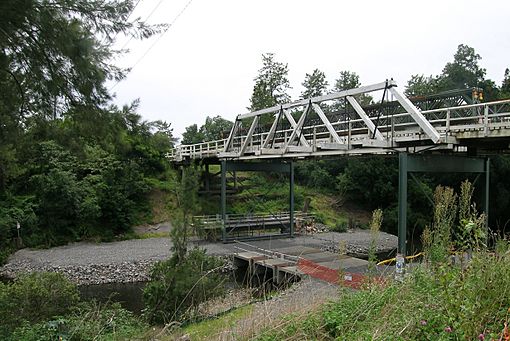Cooreei Bridge over Williams River facts for kids
Quick facts for kids Cooreei Bridge |
|
|---|---|

Cooreei Bridge over the Williams River
|
|
| Coordinates | 32°23′48″S 151°45′50″E / 32.3968°S 151.7640°E |
| Carries | Main Road |
| Crosses | Williams River |
| Locale | Dungog, Dungog Shire, New South Wales, Australia |
| Owner | Roads and Maritime Services |
| Characteristics | |
| Design | Dare truss |
| Material | Timber |
| Trough construction | Wrought iron |
| History | |
| Designer | W. J. Hanna |
| Constructed by | W. Oakes |
| Construction cost | A£1,995 |
| Opened | 1905 |
| Official name: Cooreei Bridge over Williams River | |
| Type: | State heritage (built) |
| Designated: | 20 June 2000 |
| Reference #: | 1465 |
| Type: | Road Bridge |
| Category: | Transport - Land |
The Cooreei Bridge is a special road bridge that crosses the Williams River in Dungog, New South Wales, Australia. It carries a main road, helping people travel across the river.
This bridge is considered very important because of its history and design. It is listed on the New South Wales State Heritage Register. This means it's officially recognized as a significant part of the state's history and needs to be protected. The bridge is owned by Roads and Maritime Services, which is a government group in New South Wales.
Building the Cooreei Bridge
The Cooreei Bridge was built in 1905. It's a type of truss bridge called a "Dare truss," which is a specific way of building bridges using strong triangular frames.
This bridge replaced an older one from 1873. The first bridge had become unsafe, so a new one was needed.
Who Designed and Built It?
The design and building of the Cooreei Bridge were overseen by W. J. Hanna. He was a very important engineer for roads and bridges at the time. The actual construction work was done by a builder named W. Oakes.
The bridge cost about 1,995 Australian pounds to build. The government helped by providing the iron needed for the structure.
Why the Bridge is Special
The Cooreei Bridge is important because it shows how bridges were built a long time ago. It's a great example of early 20th-century engineering in Australia.
Being on the New South Wales State Heritage Register means it's a valuable historical site. It helps us understand the past and how people used to travel and build things.

